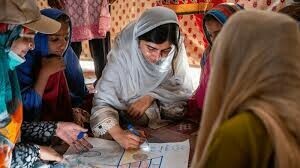Most of us believe that the issue of water scarcity that Karachiites have become so accustomed to facing is a monster that reared its head when Karachi began to bear the brunt of population boom. Not true, because half a century back, although the city’s demographic graph was changing, it hadn’t gone completely pear-shaped. On Sept 12, 1968, the main waterline behind the University of Karachi burst open, triggering, some say, the hitherto worst water crisis in the history of the Sindh capital.
On Sept 13, commissioner Karachi Syed Darbar Ali Shah ordered an inquiry into the matter. Trying to look for what caused the incident, a newspaper report suggested that the 16ft long main, which had a diameter of 84 inches, was made of steel wires covered with concrete, crushed stones, cement and sand. It was supposed to withstand the pressure of 4000 pounds of water per square inch. If the water reached the wires and rusted them, they could not bear the pressure.
On Sept 13, Karachiities searched for water by making all kinds of efforts: digging up river banks, breaking open water pipelines and resorting to using the abandoned wells. What made the sudden breakdown of the regular water supply all the more trying was the unusually hot September sun that blazed on throughout the day. The people had to devote a hard day’s labour to collect enough water to meet their minimum needs — and so, many diverted themselves from their daily chores to cart back home some drinking water.
Later in the day, thirsty citizens heaved a sigh of relief as the KDA pressed into service its standby arrangements and gave a short, low-pressure supply of water for a couple of hours. The valves of the High Service Reservoir –– connected with the Haleji Lake and Dumlottee Wells –– were opened at 4.30pm. The first to get water were the following areas: Nazimabad, Federal B Area, SITE and North Nazimabad. The valves of the supply lines feeding the old city were opened at 7pm and those of PECHS Society at about 5.30pm.
On Sept 14, over 500 water tankers were supplied to several localities from the KMC Hydrant in Muslimabad. It didn’t help the thirsty citizens a great deal. Reason: the privately owned water-carriers charged exorbitant rates. The water tankers were dispatched to affected localities, including North Nazimabad, Federal B Area and New Karachi under the orders of the deputy commissioner who had earlier requisitioned these tankers. The water carriers, however, seldom reached their destinations and were diverted by the operators to other places where water was sold at high prices.
To add salt to citizens’ wounds, on Sept 14, the weather became ruthless as the prolonged reign of clouds over the city sky ended and the day became sunny and warm. For weeks, Karachi was under an almost constant shadow of clouds, making it pleasant and cool. But clouds had now drifted off and the experts believed that this was a signal of the withdrawal of the monsoon. Any hopes for rains that the expert had entertained had now dimmed.
Weirdly enough, while weather was getting warmer, offices in Karachi enforced winter timings from Sept 15. All West Pakistan government offices were now open from 9am to 4pm instead of from 7pm to 1:45pm.
Mind you, it wasn’t just the water tanker mafia that was asking Karachiites for exorbitant amounts of money. On Sept 10, it came to the notice of Karchiites that taxi and rickshaw drivers, too, had been taking them for a ride, literally and figuratively. When the motor vehicle examiners of the Karachi Traffic Police tested the vehicles (as part of the procedural process of the new public transport fares system) it turned out that on average one out of seven fare meters was faulty. Of the 4,200 taxis and motor rickshaws tested in six days since the fares were increased, 3,600 were found to have correct meters. In all, meters of more than 600 motor rickshaws and taxis –– 15 per cent of the total –– were denied the official seal by the police, and the owners were told to come back again after getting their machines readjusted.
Published in Dawn, September 10th, 2018













































Dear visitor, the comments section is undergoing an overhaul and will return soon.